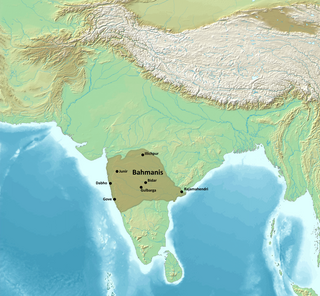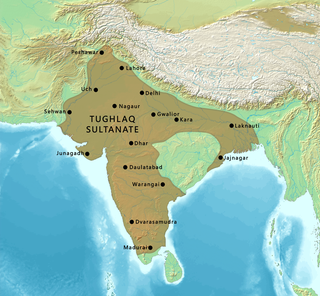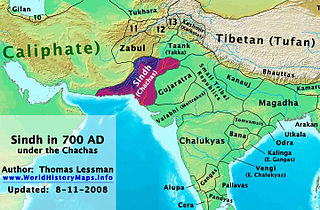Related Research Articles

Anatomically modern humans first arrived on the Indian subcontinent between 73,000 and 55,000 years ago. The earliest known human remains in South Asia date to 30,000 years ago. Sedentariness began in South Asia around 7000 BCE; by 4500 BCE, settled life had spread, and gradually evolved into the Indus Valley Civilisation, which flourished between 2500 BCE and 1900 BCE in present-day Pakistan and north-western India. Early in the second millennium BCE, persistent drought caused the population of the Indus Valley to scatter from large urban centres to villages. Indo-Aryan tribes moved into the Punjab from Central Asia in several waves of migration. The Vedic Period of the Vedic people in northern India was marked by the composition of their large collections of hymns (Vedas). The social structure was loosely stratified via the varna system, which has been incorporated into the highly evolved present-day Jāti-system. The pastoral and nomadic Indo-Aryans spread from the Punjab into the Gangetic plain. Around 600 BCE, a new, interregional culture arose; then, small chieftaincies (janapadas) were consolidated into larger states (mahajanapadas). A second urbanisation took place, which came with the rise of new ascetic movements and religious concepts, including the rise of Jainism and Buddhism. The latter was synthesised with the preexisting religious cultures of the subcontinent, giving rise to Hinduism.

The history of Pakistan preceding the country's creation in 1947. Although, Pakistan was created in 1947 as a whole new country by the Partition of India by the British Empire. Pakistan has no history prior to 1947 and was an Integral part of India. Neelis, Jason (2007), "Passages to India: Śaka and Kuṣāṇa migrations in historical contexts", in Srinivasan, Doris (ed.), On the Cusp of an Era: Art in the Pre-Kuṣāṇa World, Routledge, pp. 55–94, ISBN 978-90-04-15451-3 Quote: "Numerous passageways through the northwestern frontiers of the Indian subcontinent in modern Pakistan and Afghanistan served as migration routes to South Asia from the Iranian plateau and the Central Asian steppes. Prehistoric and protohistoric exchanges across the Hindu Kush, Karakoram, and Himalaya ranges demonstrate earlier precedents for routes through the high mountain passes and river valleys in later historical periods. Typological similarities between Northern Neolithic sites in Kashmir and Swat and sites in the Tibetan plateau and northern China show that 'Mountain chains have often integrated rather than isolated peoples.' Ties between the trading post of Shortughai in Badakhshan and the lower Indus valley provide evidence for long-distance commercial networks and 'polymorphous relations' across the Hindu Kush until c. 1800 B.C.' The Bactria-Margiana Archaeological Complex (BMAC) may have functioned as a 'filter' for the introduction of Indo-Iranian languages to the northwestern Indian subcontinent, although routes and chronologies remain hypothetical. "</ref>

Sindh is a province of Pakistan. Located in the southeastern region of the country, Sindh is the third-largest province of Pakistan by land area and the second-largest province by population after Punjab. It is bordered by the Pakistani provinces of Balochistan to the west and north-west and Punjab to the north. It shares an International border with the Indian states of Gujarat and Rajasthan to the east; it is also bounded by the Arabian Sea to the south. Sindh's landscape consists mostly of alluvial plains flanking the Indus River, the Thar Desert of Sindh in the eastern portion of the province along the international border with India, and the Kirthar Mountains in the western portion of the province.

Muslim period in the Indian subcontinent is conventionally said to have started in 712, after the conquest of Sindh and Multan by the Umayyad Caliphate under the military command of Muhammad ibn al-Qasim. It began in the Indian subcontinent in the course of a gradual conquest. The perfunctory rule by the Ghaznavids in Punjab was followed by Ghurids, and Sultan Muhammad of Ghor is generally credited with laying the foundation of Muslim rule in Northern India.

The Delhi Sultanate or the Sultanate of Delhi was a late medieval empire primarily based in Delhi that stretched over large parts of the Indian subcontinent, for 320 years (1206–1526). Following the invasion of South Asia by the Ghurid dynasty, five dynasties ruled over the Delhi Sultanate sequentially: the Mamluk dynasty (1206–1290), the Khalji dynasty (1290–1320), the Tughlaq dynasty (1320–1414), the Sayyid dynasty (1414–1451), and the Lodi dynasty (1451–1526). It covered large swaths of territory in modern-day India, Pakistan, and Bangladesh as well as some parts of southern Nepal.

Muḥammad ibn al-Qāsim al-Thaqafī was an Arab military commander in service of the Umayyad Caliphate who led the Muslim conquest of Sindh, inaugurating the Umayyad campaigns in India. His military exploits led to the establishment of the Islamic province of Sindh, and the takeover of the region from the Sindhi Brahman dynasty and its ruler, Raja Dahir, who was subsequently decapitated with his head sent to al-Hajjaj ibn Yusuf in Basra. With the capture of the then-capital of Aror by Arab forces, Muhammad ibn al-Qasim became the first Muslim to have successfully captured Indian land, which marked the beginning of Muslim rule in South Asia.

Abu al-Qasim Mahmud ibn Sabuktigin, usually known as Mahmud of Ghazni or Mahmud Ghaznavi, was Sultan of the Ghaznavid Empire, ruling from 998 to 1030. During his reign and in medieval sources, he is usually known by his honorific Yamin al-Dawla. At the time of his death, his kingdom had been transformed into an extensive military empire, which extended from northwestern Iran proper to the Punjab in the Indian subcontinent, Khwarazm in Transoxiana, and Makran.

The Gurjara-Pratihara was a dynasty that ruled much of Northern India from the mid-8th to the 11th century. They ruled first at Ujjain and later at Kannauj.

The Bahmani Sultanate was a late medieval Muslim empire that ruled the Deccan Plateau in India. The Bahmani Sultanate came to power in 1347 during the Rebellion of Ismail Mukh against the Tughlaq dynasty of Delhi after Ismail Mukh abdicated in favour of Zafar Khan, who would establish the Bahmani Sultanate. The Bahmani Sultanate was in perpetual war with its neighbors, including its rival to the south, the Vijayanagara Empire.

Islam is India's second-largest religion, with 14.2% of the country's population, or approximately 172.2 million people, identifying as adherents of Islam in a 2011 census. India also has the third-largest number of Muslims in the world. The majority of India's Muslims are Sunni, with Shia making up around 15% of the Muslim population.

Muhammad bin Tughluq, also named Jauna Khan as Crown Prince, also known by his epithets, The Eccentric Prince, or The Mad Sultan, or The Wisest Fool was the eighteenth Sultan of Delhi. He reigned from February 1325 until his death in 1351. The sultan was the eldest son of Ghiyath al-Din Tughluq, founder of the Tughlaq dynasty. In 1321, the young Muhammad was sent by his father to the Deccan Plateau to fight a military campaign against the Kakatiya dynasty. In 1323, the future sultan successfully laid siege upon the Kakatiya capital in Warangal. This victory over King Prataparudra ended the Kakatiya dynasty.

The Tughlaq dynasty was the third dynasty to rule over the Delhi sultanate in medieval India. Its reign started in 1320 in Delhi when Ghazi Malik assumed the throne under the title of Ghiyath al-Din Tughluq. The dynasty ended in 1413.

Medieval India refers to a long period of post-classical history of the Indian subcontinent between the "ancient period" and "modern period". It is usually regarded as running approximately from the breakup of the Gupta Empire in the 6th century CE to the start of the early modern period in 1526 with the start of the Mughal Empire, although some historians regard it as both starting and finishing later than these points. The medieval period is itself subdivided into the early medieval and late medieval eras.

The Muslim conquests in the Indian subcontinent mainly took place between the 13th and the 18th centuries. Earlier Muslim conquests in the subcontinent include the invasions which started in the northwestern subcontinent, especially the Umayyad campaigns during the 8th century. Mahmud of Ghazni, Sultan of the Ghaznavid Empire, preserved an ideological link to the suzerainty of the Abbasid Caliphate and invaded vast parts of Punjab and Gujarat during the 11th century. After the capture of Lahore and the end of the Ghaznavids, the Ghurid ruler Muhammad of Ghor laid the foundation of Muslim rule in India in 1192. In 1202, Bakhtiyar Khalji led the Muslim conquest of Bengal, marking the easternmost expansion of Islam at the time.

The history of Sindh refers to the history of the Pakistani province of Sindh, as well as neighboring regions that periodically came under its sway.

Ikhtiyār al-Dīn Muḥammad Bakhtiyār Khaljī, also known as Bakhtiyar Khalji, was a Turko-Afghan military general of the Ghurid ruler Muhammad of Ghor, who led the Muslim conquests of the eastern Indian regions of Bengal and parts of Bihar and established himself as their ruler. He was the founder of the Khalji dynasty of Bengal, which ruled Bengal for a short period, from 1203 to 1227 CE.

The Umayyad Dynasty came to rule the Caliphate in 661 CE, and during the first half of the 8th century CE, a series of battles took place in the Indian subcontinent between armies of the Umayyad Caliphate and Indian kingdoms situated to the east of the Indus river, subsequent to the Arab conquest of Sindh in present-day Pakistan during 711 – 713 CE.
The Mongol Empire launched numerous invasions into the Indian subcontinent from 1221 to 1327, with many of the later raids made by the Qaraunas of Mongol origin. The Mongols occupied parts of the subcontinent for decades. As the Mongols progressed into the Indian hinterland and reached the outskirts of Delhi, the Delhi Sultanate of India led a campaign against them in which the Mongol army suffered serious defeats.

India and Indonesia established diplomatic relations in 1951. Both countries are neighbours, India's Andaman and Nicobar Islands share a maritime border with Indonesia along the Andaman Sea.
Alauddin Khalji's conquest of Gujarat, also known as the Muslim Conquest of Gujarat, began in 1299 when the Delhi Sultanate ruler Alauddin Khalji sent an army to ransack the Gujarat region of India, which was ruled by the Vaghela king Karna. The Delhi forces plundered several major cities of Gujarat, including Anahilavada (Patan), Khambhat, Surat and Somnath. Karna was able to regain control of at least a part of his kingdom in the later years. However, in 1304, a second invasion by Alauddin's forces permanently ended the Vaghela dynasty, and resulted in the annexation of Gujarat to the Delhi Sultanate.
References
- 1 2 3 4 5 6 7 8 9 10 11 12 13 14 15 16 17 18 19 20 21 22 23 24 25 26 27 28 29 30 31 32 33 34 35 36 37 38 39 40 41 42 43 44 45 46 47 48 49 50 51 52 53 54 55 56 57 58 59 60 61 62 63 64 65 66 67 68 69 70 71 72 73 74 75 76 77 78 79 80 81 82 83 84 85 Richards, J.F. (1974). "The Islamic frontier in the east: Expansion into South Asia". Journal of South Asian Studies. 4 (1): 91–109. doi:10.1080/00856407408730690.
- 1 2 3 4 5 Invaders and Infidels: From Sindh to Delhi: The 500-Year Journey of Islamic Invasions
- ↑ Heroic Hindu Resistance to Muslim Invaders (636 AD to 1206 AD) by Sita Ram Goel
- 1 2 R. C. Majumdar. The History and Culture of the Indian People. Vol. 3. p. 167.
- ↑ Majumdar. 3. p. 169
- 1 2 3 4 Majumdar, R. C. Pusalkar, A. D. (ed.). History and Culture of Indian People, Classical age. p. 150.
- 1 2 3 Balakrishnan, Sandeep. Invaders and Infidels: From Sindh to Delhi: The 500-Year Journey of Islamic Invasions.
- ↑ Blankinship, Khalid Yahya (1994). The End of the Jihad State: The Reign of Hisham Ibn 'Abd al-Malik and the Collapse of the Umayyads. SUNY Press. pp. 187–189. ISBN 978-0-7914-1827-7 . Retrieved 10 May 2015.
- ↑ Tripathi, Rama Shankar (1979). History of Kanauj to the Moslem conquest. pp. 248–254.
- ↑ Majumdar. 5. p. 2
- ↑ Lal, Kishori Saran. The Legacy of Muslim Rule in India. Chapter 3: Muslims Invade India.